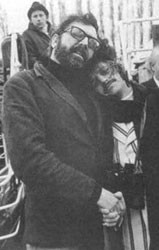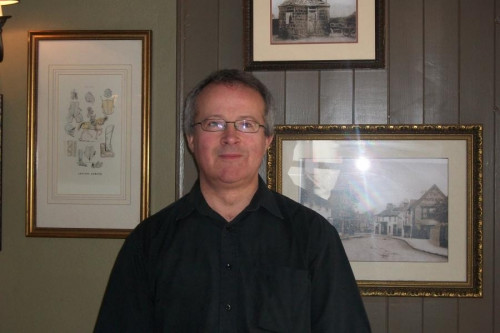The legend
A 'hart' is a male deer or stag, but the white hart took on a mythical quality through its association with Herne the Hunter (pronounced 'Ern the 'unter ).
Herne worked for Richard II in Windsor forest, but was fatally injured while defending the king against a cornered white stag. A local wizard restored him to health but, in return, Herne was forced to give up his hunting skills and eventually through frustration and disappointment hanged himself from an oak tree near the castle. Richard II subsequently adopted the White Hart as his crest. Here is a detail from a portrait of Richard 11 painted around 1306, The Wilton Diptych, showing him wearing a brooch with a white hart emblem.
King Richard's White Hart had golden antlers and a golden crown around its neck with a gold chain hanging from the crown. Heraldically, the Hart symbolises peace and harmony, the White denoting purity.
In 1389 Richard passed an Act making it compulsory for pubs and inns to have a sign outside in order to identify them to the official Ale Taster, "otherwise he shall forfeit his ale." Consequently, a great many pubs were named 'The White Hart', after Richard II's own heraldic emblem.
The history of Chobham stretches back to before Domesday, being first recorded in the 7th century, during Saxon times, although various archaeological finds show evidence of human occupation stretching back millennia.
Bronze Age
The heathland around the village may date from the late bronze age (2400-1500BC) when it is thought the woods were cleared, which would make it approximately 4000 years old. Some New Stone Age (circa 2500 BC) tools have been found, and Bronze Age (circa 1500 BC) type burial mounds (round barrows) are widespread - notably near Sunningdale, Longcross and West End.
Roman habitation has been found at Bagshot. An urn full of Roman coins was unearthed in a Chobham field and a Roman coin was found in the eastern part of the Common.
During the fifth century AD, following the withdrawal of the Romans from Britain, invading north-German Saxon tribes of warrior-farmers rowed their longboats up the Thames and established settlements in Surrey. It is believed that one of their chieftains was called Ceabba and thus the settlement he established here became known as Ceabba's Ham (ham meaning settlement). The place name evolved through the centuries to Chobham.
We can presume that Chobham would have followed the pattern of most Saxon villages of that time. It was built on a ridge of dry ground between two rivers (the Bournes). The fertile alluvial soils would have been ploughed to produce wheat, barley, rye, oats and beans.
Chertsey Abbey
The reconversion of England to Roman Christianity by missionaries in the 7th century soon led to the founding in 666 AD of a settlement of missionary priests at Chertsey. It was only some half dozen years later, when most of north-west Surrey (a name which means the 'southern area'), including Chobham, was given to this minster. This arrangement persisted for some 900 years until the dissolution of the monasteries by Henry VIII in 1537.
We do not know whether Chobham was seriously threatened by the waves of Danish raiders that troubled much of Britain, but we do know that in about 871 nearby Chertsey was attacked and fired.
As time went by, tribalism was gradually replaced by feudalism and centralised government, especially following the imposition of Norman rule in the 11th century.
Chobham, being under Chertsey Abbey, was probably spared the worst excesses of the Norman barons and the King's demands. Nevertheless, the villeins were forced by the Abbot to perform many duties on the Abbot's holding and to pay many taxes. Even after the Dissolution and right up to the 19th century the villagers were still expected to pay a one-tenth tithe to the vicar.
Chobham has always been somewhat of a backwater; bypassed by every new trend. The turnpike road developments of the 17th and 18th centuries brought prosperity to Bagshot (A30) and Ripley (A3), but they missed Chobham. The canal developments went too far to the south. The railways brought massive growth to Woking and Sunningdale, but the planned railway line to Chobham was never built.
The Inns of Chobham
The property on the right of the photograph above is the White Hart, although it is not known when this photograph was taken.
Until the 1950s Chobham had four Inns in the High Street, an indication of its one-time affluence: The Old King's Head, The Horse and Groom, the Sun Inn and the White Hart. Of these four only the last two now remain; the White Hart is probably the oldest dating back to the time when Chobham was under forest law.
The White Hart is a timber-framed building that appears to have been constructed around a pair of shops that were built around c1500 at right angles to the street. The pub would also have had stabling for up to six horses, and at some point the timber framing was in-filled with brick facings. Also to the exterior of the building there can be seen evidence of windows being bricked up some 200 years ago to avoid paying window tax. The chimney from the sitting room had to be swept from the neighbouring churchyard using an aperture in the wall, which can still be seen.
The triangle of land that now forms the terrace of the White Hart was used as a pig auction in former times, and the view through to the village cricket green behind is still intact.
Ringo Starr, Peter Sellers and The Magic Christian
In March 1969, Chobham Common feratured as a location during the filming of a whacky comedy called 'The Magic Christian', starring Peter Sellers and Ringo Starr, the drummer in the Beatles.
'The Magic Christian', based on the novel by Terry Southern, is a film that most people either really love or hate. Appearing with Sellers and Starr in the film are Pythons John Cleese and Graham Chapman, Goon Show alumnus Spike Milligan, Christopher Lee, Racquel Welch, Roman Polanski, and Yul Brenner as a lounge-singing transvestite. Paul McCartney wrote the film's theme song 'Come And Get It' performed by Badfinger.
(With thanks to Chobham.net)































